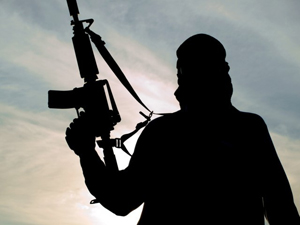
Karachi, Jun 9: At least five persons, including four security personnel, were killed on Sunday night when heavily armed militants attacked the Jinnah International Airport's old terminal in Pakistan's financial capital Karachi.
Around five to eight men armed with explosives and ammunition dressed in airport security personnel uniforms entered the Fokker building at the old airport terminal, police sources said.
“Four personnel of the Airport Security Force (ASF) have been killed and one militant gunned down,” one police source told PTI.
Heavy contingents of paramilitary rangers and police have been called in and had surrounded the Fokker building where the attackers were holed up.
All flight operations at Jinnah Terminal have been suspended and all routes to the airport have been sealed.
“Heavy firing is going on near a building located just next to the Pakistan International Airlines head office,” one eye witness said.
The old airport area houses the PIA engineering and other departments and also offices of civil aviation and ASF.
Television footage showed a loud explosion inside the old airport terminal while heavy firing also continued to go on.
A source said the militants had also carried out hand grenade attack was on the Isphani Hanger.
The attackers are said to have forged fake ID cards of ASF and entered the area.
Staff is being rescued by the security personnel and moved to safer areas, reports said, adding that rescue teams are being allowed after being checked thoroughly.
The militants are said to have entered from the Fokker gate which is used by engineering staff to go to the runaway and hangers.
Scores of people have been injured in the attack.
Pakistan Army contingents were called in from the nearby Malir cantonment to tackle the situation as Prime Minister Nawaz Sharif directed authorities to end the attack as soon as possible.
“Four airport security personnel bodies and a injured man have been brought to the Jinnah hospital,” Dr Seemi Jamali told reporters at a state-owned hospital.
TV news channels said upto 10 heavily armed men dressed in ASF uniforms forced their way into the old terminal building from different points and caught the security personnel on duty unaware.
“The four ASF men were killed by the attackers in heavy firing while one of the terrorists has also been killed in the crossfire going on,” one police official said.
Flights at the Jinnah international airports had been diverted to Nawabshah and Quettto.
“Security high alert has also been sounded off at the other airports of the country,” he said.
A senior police official said the number of the attackers was not confirmed as yet but some of them had managed to enter the runaway from the old terminal building and had fired and thrown explosives at the aircrafts parked there.
“It appears they want to damage the aircrafts on the runaway,” he said.
The old airport terminal is surrounded from one side by the Gulistan—e—Jauhar area and sources said some of the attackers had also entered the runaway directly from the Pehalwan Goth residential area by cutting the fences while others came in from the Fokker gate.
The attack is reminiscent of the deadly attack carried out by some 15 militants of the Tehreek—e—Taliban in May, 2011 on the Mehran naval airbase here in which the attackers killed some 18 personnel and damaged aircraft before being killed in a counter attack.





Comments
Add new comment